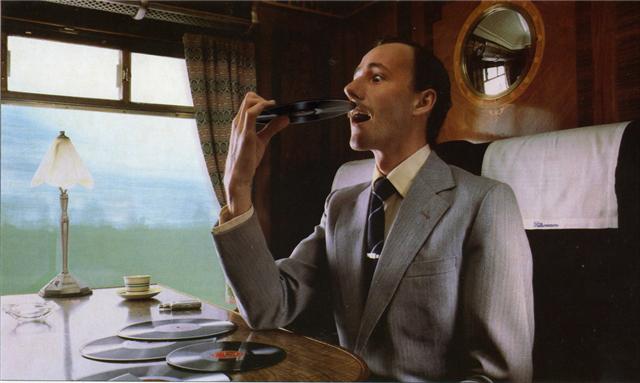jueves, abril 03, 2008
Bob Rafelson's (and Jack Nicholson's!) 'HEAD' 1968
This is one of those films where it is easy to see how some people wouldn't like it. My wife has never seen it, and when I just rewatched it last night, I waited until after she went to bed. She might have been amused by a couple small snippets, but I know she would have had enough within ten minutes.Head has nothing like a conventional story. The film is firmly mired in the psychedelic era. It could be seen as filmic surrealism in a nutshell, or as something of a postmodern acid trip through film genres. If you're not a big fan of those things--psychedelia, surrealism, postmodernism and the "acid trip aesthetic" (assuming there's a difference between them), you should probably stay away from this film. On the other hand if you are a fan of that stuff, you need to run out and buy Head now if you haven't already.Oddly, the film has never received much respect. That probably has a lot to do with preconceptions. After all, it does star The Monkees--Micky Dolenz, Davy Jones, Michael Nesmith and Peter Tork--and The Monkees were a musical group of actors put together by producers Bob Rafelson and Bert Schneider to be a kid-friendly, bubble-gummy Beatles for a television series. In their era, they had as much respect as, say, Menudo, New Kids on the Block, The Spice Girls, and so on. As a fellow IMDb reviewer rightly notes--"Perhaps people in 1968, thinking of the Monkees as a silly factory-made pop band rip-off of the Beatles, refused to see (Head)".The Monkees and Head have never been quite able to shed that negative public perception. It's a shame, because there was a lot of talent, both musically and otherwise, in The Monkees. It's probably odder that Rafelson, who directs here and co-produces with Schneider, and Jack Nicholson (yes, _that_ Jack Nicholson), who wrote the script and also co-produces, decided to take The Monkees in this unusual direction. It's as if New Kids on the Block suddenly put out an album equivalent to Pink Floyd's Ummagumma (1969) or Atom Heart Mother (1970). In fact, the songs in Head, written by The Monkees and frequent collaborators such as Carole King and Harry Nilsson, have a Floyd-like quality, somewhere between the Syd Barrett era and the immediate post-Barrett era. This is much more prominent than any Beatles similarity. Some people have complained about the music in the film, but to me, all the songs are gems. For that matter, some people dislike Barrett era (or other) Floyd, which is just as difficult for me to empathize with.But what _is_ Head about? The basic gist is just that The Monkees are taking a trip through various film genres--there are war scenes, adventure scenes, horror scenes, comedy scenes, drama scenes, western scenes, sci-fi scenes, romance scenes, and on and on. Except, in the film's reality, this turns out to be happening primarily (if not exclusively) on a studio lot. At root, we're watching The Monkees shoot a film. Of course all of the scenes in the various genres have something surreal and self-referential about them, and they, and individual shots within a scene, tend to lead to one another using dream logic not dissimilar to the Monty Python television show. As a dream, Head tends to vacillate between a good dream and a nightmare, while often being one that would cause you to laugh in your sleep (something that I frequently do, by the way).Technically, Rafelson uses a wide variety of techniques to realize the above. There are scenes with extensive negative images, there are a lot of very fast cuts (including a great sequence that features Davy Jones and Tony Basil dancing alternately in a white and a black room, wearing a combination of white and black reversed in each, that occasionally toggles back and forth as quickly as two frames at a time), there are a lot of bizarre segues, there is an animated cow mouth, there are odd editing devices, and so on. For my money, I wish this stuff wasn't just a relic of the psychedelic era. This is the kind of artistic approach I relish. It seemed like a good idea back then and I still think it's a good idea. I'd like to see films like The Life Aquatic with Steve Zissou using (2004) using these types of extended techniques. Now that would make that film surreal.Interpretationally, some folks who aren't so in tune with the acid trip aesthetic have complained that it's basically b.s. to offer meanings for something intended to not have any. I disagree with such a pessimistic/nihilistic view; Head was intended to have a lot of meaning(s), and it's not just films without conventional plots that have multiple interpretations. Nicholson, Rafelson and Schneider have a lot of interesting things to say about The Monkees--the film postmodernistically comments on their manufactured status; pop stardom--way before Pink Floyd, Head conflates pop stardom and violence, from images of war to images of fans cannibalistically dismantling their idols; and naïve U.S.-oriented ideas of international perceptions and respect--well-armed foreigners in a desert surrender to Micky Dolenz just because he's an American, then later they blow up a Coke machine (again in the desert) for him because he's thirsty and can't gain access. The film comments on many other topics--from big Industry to police, surveys, spectatorship (especially in relation to tragedies), and on and on. Head is full of ideas, appropriately enough, with intelligent, multifaceted things to say about them.Head deserves to be considered a classic--it's basically shooting for the same vibe as The Beatles' Yellow Submarine. Both premiered in November of 1968, interestingly enough, and both were intended as something of a summation of the psychedelic aesthetic. Yellow Submarine wasn't quite successful. Head is everything Yellow Submarine should have been.
Suscribirse a:
Comentarios de la entrada (Atom)

No hay comentarios.:
Publicar un comentario